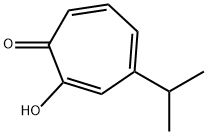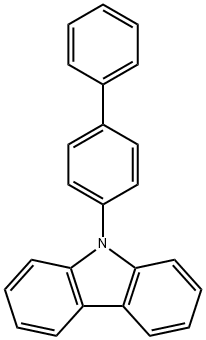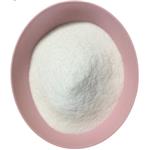Chemical Properties
Hinokitiol is a tropolone derivative containing an unsaturated seven-membered carbon ring. It is a monoterpenoid – cyclohepta-2,4,6-trien-1-one substituted by a hydroxy group at position 2 and an isopropyl group at position 4. It is a enol and a cyclic ketone. It derives from a hydride of a cyclohepta-1,3,5-triene. Thujaplicins are soluble in organic solvents and aqueous buffers.Hinokitiol provides acetone on vigorous oxidation and gives the saturated monocyclic diol upon catalytic hydrogenation.It is stable to alkali and acids, forming salts or remaining unchanged, but does not convert to catechol derivatives. Hinokitiol, as other thujaplicins and tropolones, reversibly binds metal ions. It forms complex salts with metal ions.
benefits
Hinokitiol (β-thujaplicin) is a naturally occurring antioxidant, found in the heartwood of certain plants. It acts as a metal chelator and, also, enhances the activity of superoxide dismutase (Huang et al., 2015). It was found to be very protective in the assay. It has not been previously studied as a HC protectant. In addition to its antioxidant properties, hinokitiol has been shown to reduce inflammation via suppression of NFκB, and metalloproteinases, and to activate caspase 3. The former activities could contribute to its protective effect.
Hinokitiol is a superpower ingredient that has anti-inflammatory, antioxidant, antibacterial, anti-fungal and anti-melanogenic properties. Best of all, hinokitiol is as gentle as it is powerful. Hinokitiol’s properties allow it to target the inflammatory redness and blemishes seen in rosacea and acne. Hinokitiol is effective against P. acnes bacteria, and there is no known acquired resistance to it, unlike other prescription antibiotics.
Safety
The safety of hinokitiol has been tested in rats and no carcinogenic effect to rats was found.In 2006, hinokitiol was categorized under the Domestic substances list (DSL) in Canada as non-persistent, non-bioaccumulative and non-toxic to aquatic organisms.
Description
Hinokitiol (β-thujaplicin) is a natural monoterpenoid found in the wood of trees in the family Cupressaceae. It is a tropolone derivative and one of the thujaplicins.Hinokitiol is used in oral and skin care products,and is a food additive used in Japan.
Uses
Antibacterial additive in foods, cosmetics, eye drops and toothpaste.
Uses
Hinokitiol is a natural monoterpenoid found in the wood of trees in the family Cupressaceae. It is a tropolone derivative and one of the thujaplicins. Hinokitiol has inhibitory effects on Chlamydia trachomatis and may be clinically useful as a topical drug.
Definition
ChEBI: A monoterpenoid that is cyclohepta-2,4,6-trien-1-one substituted by a hydroxy group at position 2 and an isopropyl group at position 4. Isolated from Thuja plicata and Chamaecyparis obtusa, it exhibits antimicrobial activities.
Anticancer Research
Studied in xenograft tumors such lung adenocarcinoma cell, EGFR-TKI-resistantlines PC9-IR and H1975 in which the growth inhibition was observed, a novel antitumormechanism was hypothesized. In summary, the hinokitiol can induce DNAdamage and autophagy (Rodrigues et al. 2015).
References
1) Ido et al (1999) Induction of apoptosis by hinokitiol, a potent iron chelator, in teratocarcinoma F9 cells is mediated through the activation of caspase-3; Cell Prolif., 32 63
2) Suzuki et al. (2000) Hinokitiol, a selective inhibitor of the platelet-type isozyme of arachidonate 12-lipoxygenase; Biochem. Biophys. Res. Commun., 275 885
3) Morita et al. (2007) The mechanism of the bactericidal activity of hinokitiol; Biocontrol Sci., 12 101
4) Liu and Yamauchi (2006) Hinokitiol, a metal chelator derived from natural plants, suppresses cell growth and disrupts androgen receptor signaling in prostate carcinoma cell lines; Biochem. Biophys. Res. Commun., 351 26
5) Lee et al. (2010) Hinokitiol activates the hypoxia-inducible factor (HIF) pathway through inhibition of HIF hydroxylases; Biochem. Biophys. Res. Commun., 396 370







